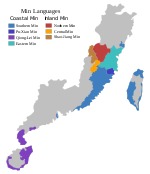Xiapu dialect
Appearance
| Xiapu | |
|---|---|
| 霞浦話 | |
| Native to | Southern China |
| Region | Xiapu, Ningde, Fujian |
Early forms | |
| Language codes | |
| ISO 639-3 | – |
| Glottolog | None |
| Linguasphere | 79-AAA-ibe |
The Xiapu dialect (Eastern Min: 霞浦話; Foochow Romanized: Hà-puō-uâ) is a dialect of Eastern Min Chinese spoken in Xiapu, Ningde in northeastern Fujian province of China.
Phonology
[edit]The Xiapu dialect has 15 initials, 43 rimes and 7 tones.
Initials
[edit]| Bilabial | Dental | Alveolar | Velar | Glottal | ||
|---|---|---|---|---|---|---|
| Nasal | m 蒙 |
n 日 |
ŋ 語 |
|||
| Stop | Aspirated | pʰ 波 |
tʰ 他 |
kʰ 氣 |
||
| Tenuis | p 邊 |
t 低 |
k 求 |
ʔ 鶯 | ||
| Fricative | (β) | θ 時 |
(ʒ) | x 喜 |
||
| Affricate | Aspirated | ʦʰ 出 |
||||
| Tenuis | ʦ 曾 |
|||||
| Lateral | l 柳 |
|||||
Rimes
[edit]| a | ia | ua | ai | au | uai |
| aŋ | iaŋ | uaŋ | aiŋ | ɔuŋ | |
| aʔ | iaʔ | uaʔ | aiʔ | ɔuʔ | |
| ɛ, ɔ | ɛu | ||||
| ɔʔ | |||||
| e, o | ø | oi | eu | ||
| eiŋ, ouŋ | yoŋ | ||||
| eiʔ, ouʔ | øʔ, yoʔ | ||||
| u | iu | ui | |||
| uŋ | yuŋ | ||||
| uʔ | yuʔ | ||||
| i, y | |||||
| iŋ | |||||
| iʔ |
Tones
[edit]| No. | 1 | 2 | 3 | 4 | 5 | 6 | 7 |
|---|---|---|---|---|---|---|---|
| Tone name | dark level 陰平 |
light level 陽平 |
rising 上聲 |
dark departing 陰去 |
light departing 陽去 |
dark entering 陰入 |
light entering 陽入 |
| Tone contour | ˦ (44) | ˨ (22) | ˦˨ (42) | ˧˥ (35) | ˨˩˨ (212) | ˥ (5) | ˨ (2) |
Initial assimilation
[edit]The two-syllable initial assimilation rules are shown in the table below:
| The Coda of the Former Syllable | The Initial Assimilation of the Latter Syllable |
|---|---|
| Null coda or /-ʔ/ |
|
| /-ŋ/ |
|
| /-k̚/ | All initials remain unchanged. |
Tone sandhi
[edit]The two-syllable tonal sandhi rules are shown in the table below:
| the second syllable | ||||||||
|---|---|---|---|---|---|---|---|---|
| the first syllable | dark level 44 |
light level 22 |
rising 42 |
dark departing 35 |
light departing 212 |
dark entering 5 |
light entering 2 | |
| dark departing 35 |
55 | 51 | ||||||
| dark entering 5 | ||||||||
| rising 42 |
51 | 5 | ||||||
| dark level 44 |
44 | |||||||
| light departing 212 |
||||||||
| light entering 2 | ||||||||
| light level 22 |
22 | |||||||
Notes
[edit]References
[edit]- ^ Mei, Tsu-lin (1970), "Tones and prosody in Middle Chinese and the origin of the rising tone", Harvard Journal of Asiatic Studies, 30: 86–110, doi:10.2307/2718766, JSTOR 2718766
- ^ Pulleyblank, Edwin G. (1984), Middle Chinese: A study in Historical Phonology, Vancouver: University of British Columbia Press, p. 3, ISBN 978-0-7748-0192-8
- ^ Hammarström, Harald; Forkel, Robert; Haspelmath, Martin; Bank, Sebastian (2023-07-10). "Glottolog 4.8 - Min". Glottolog. Leipzig: Max Planck Institute for Evolutionary Anthropology. doi:10.5281/zenodo.7398962. Archived from the original on 2023-10-13. Retrieved 2023-10-13.
- Compilation Commission of Chorography of Xiapu County 霞浦县地方志编纂委员会 (1990). Xia pu xian zhi 霞浦县志 ["Chorography of Xiapu County"]. Vol. 27. Beijing: Fangzhi chubanshe 方志出版社 ["Chorography Press"]. ISBN 7-80122-542-2.

